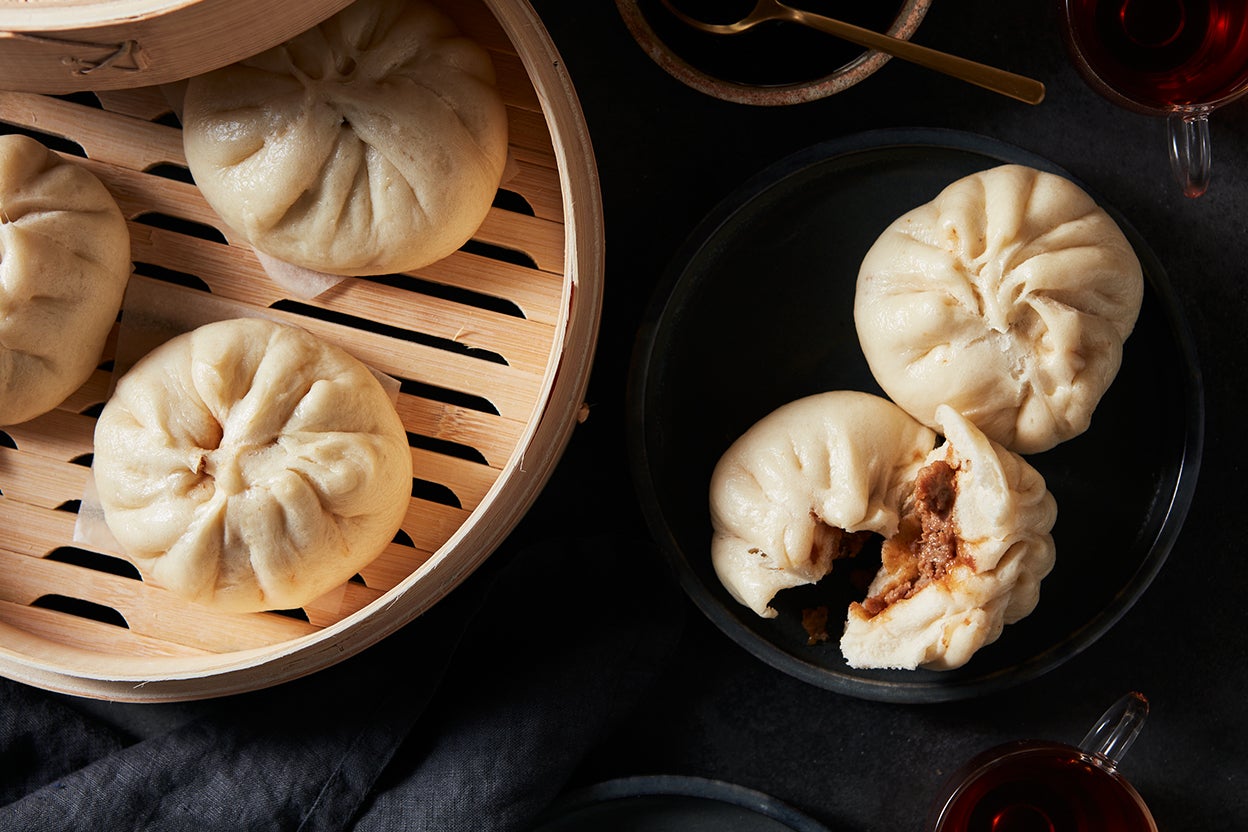Steamed Pork Buns (Xian Rou Bao)
4.8
(5)
Your folders
Your folders
Prep Time: 1 hours
Cook Time: 15 minutes
Total: 2 hours, 30 minutes
Servings: 12
Author : King Arthur Baking

Ingredients
Export 13 ingredients for grocery delivery
Instructions
Step 1
To make the dough : In a medium bowl or bowl of a stand mixer, combine all the dough ingredients and knead — by hand or with a mixer — to make a soft, elastic dough, about 8 to 10 minutes in a stand mixer. (It’ll take a bit longer if kneading by hand.)
Step 2
, Place the dough in a lightly greased bowl, cover, and let it rise for 60 to 90 minutes, until it's nearly doubled in bulk.
Step 3
, To make the filling: First, make ginger-scallion water. In a blender or food processor, combine water, scallion, and ginger and blend until smooth. Strain through a sieve to collect the flavored water. Compost or discard the solids and set aside the remaining liquid.
Step 4
, In a medium bowl, combine all of the filling ingredients except for the ginger-scallion water. With a spatula, mix the filling in one direction (this is said to align the fibers of the meat, incorporate air, and create a fluffier filling).
Step 5
, Stirring in the same direction, add the ginger-scallion water, one tablespoon at a time, being sure to incorporate the water in the filling before adding another tablespoon. Stop adding ginger-scallion water when the filling is sticky, airy, and almost paste-like in consistency. It should not be gritty like the original texture of the ground pork. Set aside.
Step 6
, To shape : Gently deflate the dough and divide in half (about 350g each). Cover one piece as you work with the other; it’s helpful to prepare the bao in two batches.
Step 7
, Cut 3" squares of parchment or use steamer liners. (See “tips,” below for our specific equipment recommendations.) Roll the dough into a log and divide into 6 portions (about 58g each). Place one piece cut-side down on a lightly floured surface and flatten into a disk with your palm. Use a rolling pin to roll the disk into a 4" to 5" round, making sure the edges are thinner than the middle (this will make it easier to pleat). To achieve thin edges, hold the dough in your non-dominant hand, rotating it gradually as you roll out the edges of the circle using a pin in your dominant hand. (A wooden dowel or a small tapered rolling pin is the best tool here.)
Step 11
, Use a tablespoon scoop or measuring spoon to place heaping tablespoon (about 41g) of filling in the center of the rolled out dough. Pleat into a bao, leaving a small steam hole opening at the top. (For more detailed shaping instructions, see “tips,” below.) Place each shaped bao on a parchment square and place in the steamer basket or on a baking sheet to rise. Be sure to leave a few inches of space between the buns.
Step 15
, Shape and fill the remaining five pieces of dough; this completes the first batch.
Step 16
, Place the bao, covered, in a warm place to rise for an additional 15 to 20 minutes.
Step 17
, While the first batch of bao are rising, set up your steamer. You can use multiple bamboo steaming trays, or a stock pot with steaming inserts. Begin shaping the second batch of bao using the remaining log of dough and filling.
Step 18
, Steam the bao for 15 minutes over medium steam, until the bao are firm and bounce back when poked. Repeat with the remaining batch until all the bao are steamed and cooked through.
Step 19
, Storage information : Serve immediately. Allow any leftovers to fully cool before storing, covered, in the refrigerator for several days or in the freezer for longer storage. To reheat from the refrigerator, re-steam the bao for 2 to 3 minutes. To reheat from the freezer, re-steam for 6 to 8 minutes.